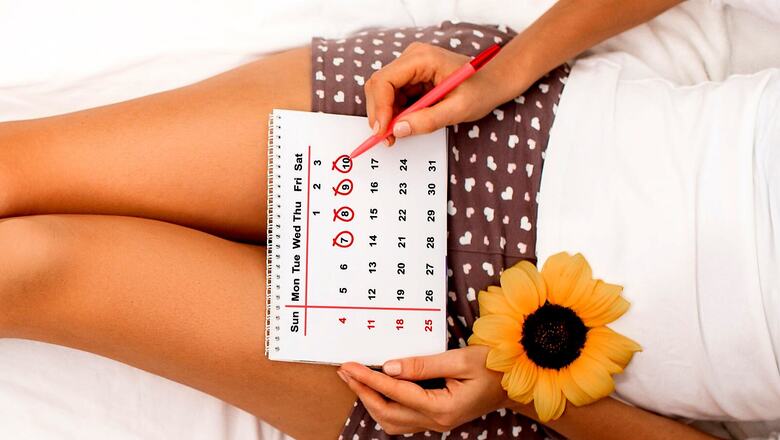
views
To address the widespread misinformation about sex, News18.com is running this weekly sex column, titled ‘Let’s Talk Sex’, every Friday. We hope to initiate conversations about sex through this column and address sexual health issues with scientific insight and nuance.
The column is being written by Sexologist Prof (Dr) Saransh Jain. In today’s column, Dr Jain talks about signs of ovulation.
The first step in a woman’s pregnancy journey is to know the time she is most fertile in her menstrual cycle. Although the fertile days are not obvious, there are a few signs which one can look out for, to identify the fertility window. These changes happen to bodies in the lead up to the release of an egg cell (known as ovulation). Every woman is different and her experience of ovulation is unique to her.
The Ovulation Window
On average, a woman with regular cycles tends to ovulate sometime between day 11 and day 21 of her cycle. (Day 1 is the day you get your period.) This means a woman’s most fertile days will fall somewhere between day 8 and day 21.
If your cycles are on the shorter side, you’re more likely to ovulate closer to day 11. If you have longer menstrual cycles, ovulation may occur closer to day 21. But “some time” between day 11 and day 21 is quite a long range. Some ovulation signs indicate that ovulation is approaching. This allows you to time sex for pregnancy. Others let you know that ovulation has passed. This can be reassuring, giving you confidence that you did ovulate. Here are few signs of ovulation.
Signs of Ovulation
Determining your exact ovulation day can be tricky, but there are several ways to tell when you’re at your most fertile point in your cycle. Here are some signs that ovulation is coming or that ovulation has just occurred.
Increased Sexual Desire
Also known as libido, sex drive reflects our desire for sex and can fluctuate throughout the menstrual cycle. An increase in libido is linked to the hormone estrogen, which is high during the days before ovulation.
Increasing Energy Levels
As the fertile window approaches, a rise in activity level isn’t restricted to the bedroom. In fact, we’re likely to feel at our very best in the days leading up to ovulation. Energy levels are high, so it’s a good time to take on new challenges or channel that motivation into something that needs you to be at the top of your game!
Changing cervical mucus
Just like your sex drive and energy levels, cervical mucus levels flow throughout the cycle as well. In the days before ovulation, this discharge becomes clear, and is very stretchy with a highwater content. Cervical mucus with this consistency is sometimes called “egg white” cervical mucus and is often a sign that ovulation day is approaching.
Shining Complexion
There’s a link between your skin and hormones. In the days before ovulation, some women experience clearer skin and a glowing complexion caused by the presence of estrogen. Others might get the occasional breakout around ovulation day instead. These breakouts are caused by rising progesterone levels that happen alongside ovulation. However, we’re more likely to experience spotty skin after ovulation itself when estrogen levels have dropped, but those progesterone levels remain high.
Feeling Pain
It’s not all high sex drive, boundless energy, and beautifully clear skin. Some women do experience some soreness as a sign of ovulation too. Breast tenderness on ovulation day is a common symptom, and some women also get a one-sided abdominal soreness known as ovulation pain or Mittelschmerz, which happens as the egg cell is released from the ovary.
Surging Hormones
So far, we’ve covered signs of ovulation that can be directly seen or felt. The problem with predicting ovulation with the five signs above is that they are all highly subjective, and not everyone experiences them. However, there are other biological changes happening in women bodies that are easier to measure and can help us pinpoint ovulation day.
Rise in Body Temperature
One way to confirm ovulation has happened though is to measure basal body temperature. Due to the change in hormones
that happen around ovulation, our resting body temperature rises. To measure this, you need to use a sensitive thermometer that shows two decimal places and measure first thing in the morning before you get out of bed.
Ovulation isn’t the only key to Conception
We hope that you’ve enjoyed reading all about the signs and symptoms of ovulation. You can use what you’ve learned about ovulation to get pregnant faster. That said, even if your fertility is “perfect,” don’t expect to conceive your very first month of trying.
However, ovulation isn’t the only key to conception. It’s just one part of the puzzle. The health of the overall reproductive system in both partners is also important. If you’re struggling to conceive, and you’re pretty sure you’re ovulating, don’t assume this means everything is OK. See your doctor and get checked out. The good news is that most couples with fertility challenges will be able to get pregnant with the help of fertility treatments.
Read all the Latest News , Breaking News and IPL 2022 Live Updates here.



















Comments
0 comment